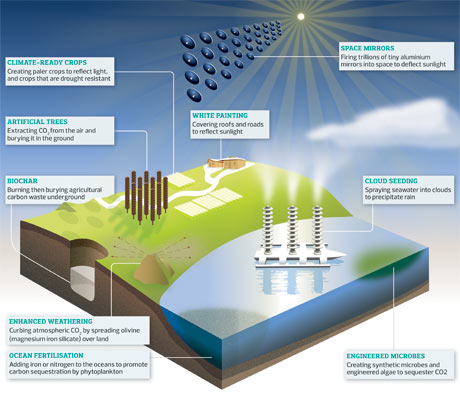Critics fear that manipulating weather patterns could have a calamitous effect on poorer countries

Techno-fix ideas include artificial trees and firing silver iodide into clouds to produce rain. Photograph: Peter Andrews/Reuters
The alert on the Climate Ark website in January 2009 was marked urgent: "Take action: A rogue science ship is poised to carry out risky experimental fertilisation of the Southern Ocean. This is likely [to be] the first of many coming attempts to begin geo-engineering the biosphere as a solution to climate change. The chemical cargo is likely to provoke a massive algal bloom big enough to be seen from outer space..."
The response was immediate and vitriolic: "You morons," fumed a woman from a Canadian university. "That isn't a rogue ship... it's one of the best marine science research groups in the world. You are no different than anti-science religious fanatics. You seek to keep the world ignorant. May you drown in your lies..."
Professor Peter Liss, then chair of Britain's Royal Society's global environment research committee and himself involved in research to see the effect of iron on phtyoplankton, stepped in: "The [intention] is to find out what role iron plays in marine biogeochemistry. In no way is it an attempt to geo-engineer the planet. Only by knowing the facts can you argue effectively against such geo-engineering proposals. Emotion and opinion will not win the argument; knowledge and understanding will."
Some hope. Geo-engineering – artificial efforts to mitigate global warming by manipulating weather patterns, oceans, currents, soils and atmosphere to reduce the amount of greenhouses gases – evokes ideological, political and financial passions. For those who have more or less given up on UN climate talks, it is, along with nuclear power, the only practical planetary way to avoid catastrophic climate change; for others, it is an irresponsible move into the unknown by the rich world that will inevitably have unintended consequences, most probably for the poorest.
But as attempts to get major economies to agree to reduce emissions through energy efficiency falter, so groups of scientists, universities and entrepreneurs are coming together, patenting ideas and pressing the case with governments and the UN to back experiments as the first step towards wide-scale deployment of a suite of technologies.
From just a few individuals working in the field 20 years ago, today there are hundreds of groups and institutions proposing experiments. They fall broadly into two camps: one aims to remove greenhouse gases from the air and store them underground; the other, more controversially, tries to cool the Earth down by reflecting sunlight from the atmosphere or space in a process known as solar radiation management.
The range of techno-fix ideas is growing by the month. They include absorbing plankton, growing artificial trees, firing silver iodide into clouds to produce rain, genetically engineering crops to be paler in colour to reflect sunlight back to space, fertilising the ocean with iron nanoparticles to increase phytoplankton, blasting sulphate-based aerosols into the stratosphere to deflect sunlight, covering the desert with white plastic to reflect sunlight and painting cities and roads white.
There are serious proposals to launch a fleet of unmanned ships to spray seawater into the atmosphere to thicken clouds and thus reflect more radiation from Earth. Most controversial of all is an idea to fire trillions of tiny mirrors into space to form a 100,000-mile "sunshade" for Earth.
Most are unlikely to be seriously considered but some are being pushed hard by entrepreneurs and businessmen attracted by the potential to make billions of dollars in an emerging system of UN global carbon credits. Research by ETC, the Canadian-based watchdog, shows at least 27 patents have been granted to inventors and assignees including Bill Gates, Dupont, the US government and various corporations. Chemical engineer Michael Markels has four patents, Professor Steven Salter of Edinburgh University and climate change scientist David Keith have two.
"If geo-engineering techniques move towards actual deployment, the existence of patents could mean that decisions over the climate will be effectively handed over to the private sector," says Diana Bronson of ETC.
In what is shaping up to become a deep, ideological division along the lines of pro- and anti-nuclear or GM crops, the scientists, corporates and entrepreneurs are being broadly opposed by environment groups and developing countries, but backed increasingly by the UK and US governments, as well as businessmen such as Richard Branson. And in a strange new grouping, free market environmentalists such as Mark Lynas in Britain, Stewart Brand in the US and Bjorn Lomborg in Denmark have joined high-profile US conservative politicians and thinktanks to say geo-engineering is a step forward.
"Geo-engineering holds forth the promise of addressing global warming concerns for just a few billion dollars a year," said Newt Gingrich, former speaker of the US House of Representatives, in 2008. "We would have an option to address global warming by rewarding scientific innovation. Bring on American ingenuity. Stop the green pig."
 How geo-engineering plans to combat climate change. Click here to see a full size version of the graphic
How geo-engineering plans to combat climate change. Click here to see a full size version of the graphicSuch people have decided that re-engineering Earth for survival, or for profit, is just an intellectual skip away from what we have been doing for centuries and what has got us into the mess in the first place – cutting down most of the world's forests, converting the savannas, diverting and damming rivers and plundering the seas. With no evidence that mankind is prepared to reduce the emissions of greenhouse gases, it has become necessary to have a plan B, an insurance policy for the situation in which Earth hits a tipping point, they argue.
But to do that requires experiments and money, says Andrew Lockley, moderator of the geoengineering group Google site that brings together many of the world's leading scientists working in different areas. His own area is finding geo-engineering ways to capture methane on a vast scale from melting tundra landscapes.
Lockley says: "We just do not know if a catastrophic methane release could be 50, 100 or 10,000 years away. Different scientists are saying different things. We could be sleepwalking into a climate disaster. What is needed is the support of academe to do further research. We need basic research done on which models might work."
But with most major research institutions scared of the public reaction and hesitating to put money into geo-engineering, it is being left to corporations and billionaire entrepreneurs. Bill Gates has put in $400m (£250m) into two projects and is named in a group of people holding a patent to employ a fleet of vessels to suppress hurricanes through various methods of mixing warm water from the surface of the ocean with colder water at greater depths. Richard Branson's "carbon war room" is backing carbon capture and storage technologies. Behind the scenes, airlines, GM and chemical companies are believed to be cautiously investigating the potential.
Britain now leads the world's public funding, by providing research money and intellectual backing from scientific institutions such as the Royal Society. Last week, the Engineering and Physical Sciences Research Council, a British government funding agency, released over £3m for two geo-engineering research projects.
The most controversial project is for an artificial mini-volcano to block sunlight and lower temperatures. Inspired by the way eruptions can spew particles into the stratosphere dimming the sun and lowering temperatures, the scientists from Bristol, Cambridge and Reading Universities propose to launch a massive balloon system 20-25km into the stratosphere to spray millions of sulphate particles. The prototype will put a balloon just 1km into the sky.
Their work is being mirrored in the California where Philip Rasch, chief scientist for climate science at the Pacific Northwest National Laboratory, a research group with the US Department of Energy, has proposed fleets of aircraft continually spraying tons of reflective sulphur dioxide into the stratosphere. Geo-engineering critics are appalled, saying the diffusion of the sunlight might result in ozone depletion, reduced plant growth, more humidity in the atmosphere, less energy and even potential damage as particles fall to Earth.
"We just do not know how to recall a planetary-scale technology once it has been released. Techniques that alter the composition of the stratosphere or the chemistry of the oceans are likely to have unintended consequences as well as unequal impacts around the world," says Pat Mooney of ETC.
Scientists are also divided on the deployment of planetary-scale geo-engineering but united on the need for research – if only to show that many of the proposed schemes may be rubbish.
"I am actually pretty scared of putting things in space. Some people are planning to do it [but] it is much harder to check what is going on in the stratosphere. We may need to regulate the experiments. We know very little about secondary consequences. To talk about doing it is naive. To do research is different," he says. "The case for experimentation is not the case for going ahead with major implementation. You cannot consider [these things] until you have done the research. Maybe it goes no further. A first step does not presume a second. That would be for politicians to decide."
But the technologists are at many different stages. According to ETC, there are now several groupings, including the pragmatists, such as Branson, Lomborg and the American Enterprise Institute, which argue that geo-engineering is faster and cheaper than carbon taxes and emissions reductions, so just get on with it; and the theorists, such as the Royal Society and the Carnegie Institution for Science in the US which say we must have an emergency Plan B because we are heading for a certain climate catastrophe; meanwhile, businesses such as the Ocean Fertilisation Company and the Biochar Initiative see dollars.
In the background is the military. According to US science historian James Fleming, control of the climate gives the military an advantage and so it seeks to "weaponise" every technology, providing a stream of resources for scientists. Star Wars architect Lowell Wood argued in the 1990s that by spending about $1bn per year, the US could put enough particles in the stratosphere to reduce sunlight by about 1%.
"It is not easy to see how a serious geo-engineering programme could move forward without some degree of military involvement," says Jeff Goodell, journalist and author of How to Cool the Planet.
The immediate battle, though, is being fought in the media, where the scientists are hoping to be hailed as social visionaries, and in the UN and scientific establishments, where they are seeking intellectual underpinning. According to Bronson: "The geo-engineers have worked hard to conquer the western scientific establishment and are now moving into Brazil, India and China because they know that the northern orientation of everything so far is a huge liability."
There is growing awareness that geo-engineering is not going away, adds Bronson. "Many NGOS and social movements in Latin America have started to get involved and interest in south-east Asia and some parts of Africa is growing. Combined with lacklustre climate talks and rising emissions, though, many environmentalists end up with some kind of reluctant endorsement of the 'more research' agenda. Indigenous peoples and farmers' organisations have proved particularly strong in their opposition. Women's groups are also starting to get interested and alarmed."
Above all, it will be the governments of poor countries which are likely to object to any planetary-scale project. Two years ago, all countries except the US agreed to a de facto voluntary moratorium on geo-engineering projects and experiments. Apart from the unpredictability of the science, there was mistrust that western-northern-driven technological solutions to climate change would be fair or equitable. Two weeks ago, 160 organisations from around the world sent an open letter to Rajendra Pachauri, the Nobel prize-winning chair of the UN Intergovernmental Panel on Climate Change, after it had hosted a meeting of geo-engineers in Lima, Peru.
"Geo-engineering is too dangerous to too many people and to the planet to be left in the hands of small group of so-called experts," they warned. "The IPCC has assured us it will go forward carefully in this work. We will be closely following the process."


![[SB10001424053111903596904576515221456886038]](http://s.wsj.net/public/resources/images/OB-PE984_0818dr_D_20110817224056.jpg)
![[ROBOWAR]](http://si.wsj.net/public/resources/images/MK-BO427_ROBOWA_DV_20110818181355.jpg)





 31 Comments
31 Comments